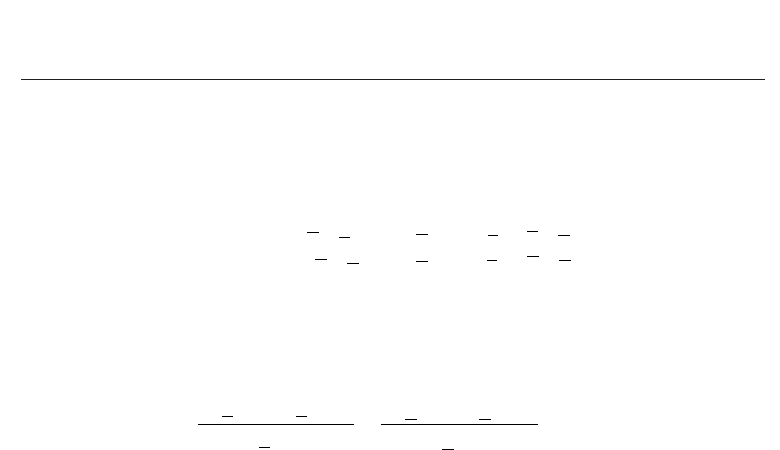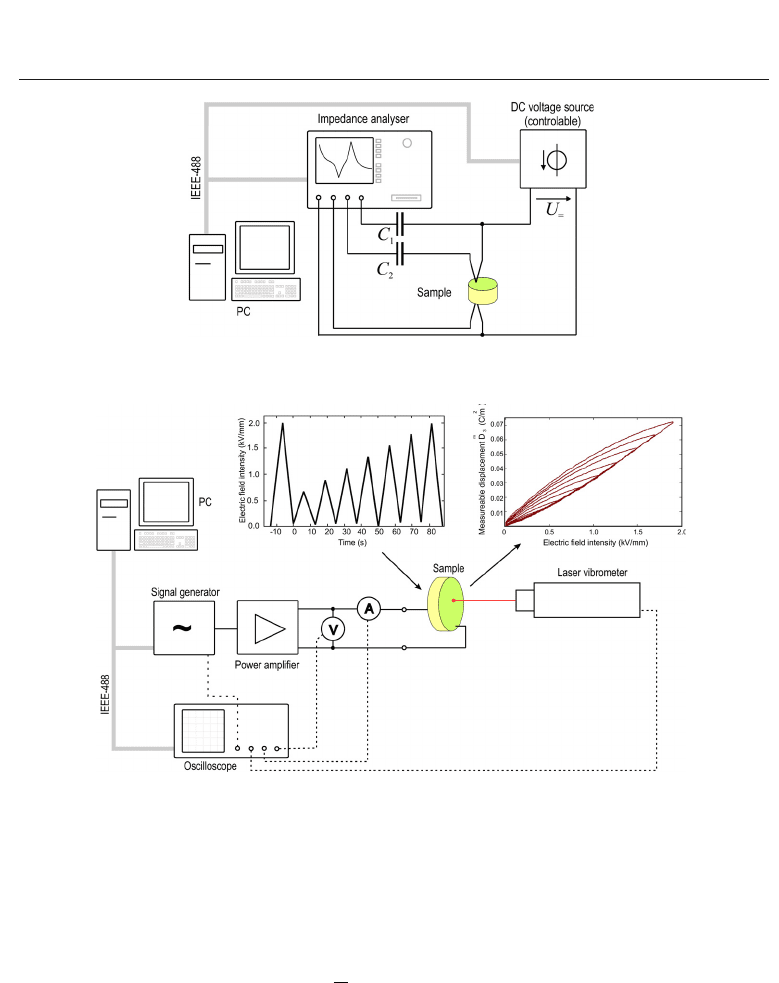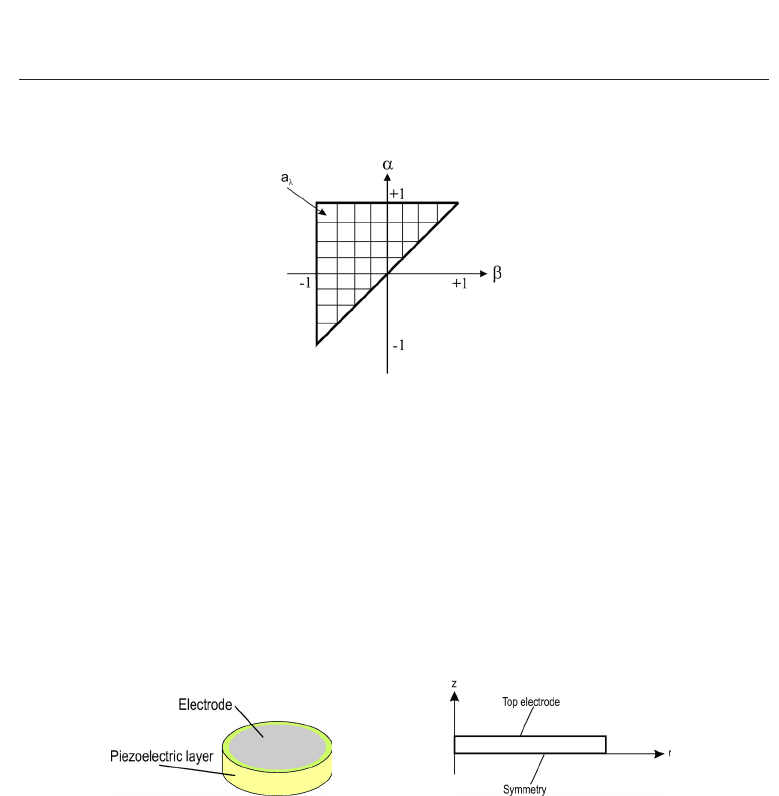Lallart M. Ferroelectrics: Characterization and Modeling
Подождите немного. Документ загружается.


Modeling and Numerical Simulation
of Ferroelectric Material Behavior Using Hysteresis Operators 9
efficiently by just evaluation of a sum over the string entries
H(s)=h(−e
0
, e
0
)+
N
∑
k=1
h(e
k−1
, e
k
) ∀s =(e
0
,...,e
N
) (8)
instead of computing the integrals in Equation (1). In Equation (8) h is the so-called shape
function or Everett function (cf. Everett (1955)), which can be precomputed according to
h
(e
N−1
, e
N
)=2 sign(e
N
−e
N−1
)
Δ(e
N−1
,e
N
)
℘(β, α) d (α, β) . (9)
4. Piezoelectric model
We follow the basic ideas discussed in Kamlah & Böhle (2001) and decompose the physical
quantities into a reversible and an irreversible part. For this purpose, we introduce the
reversible part D
r
and the irreversible part D
i
of the dielectric displacement according to
D
= D
r
+ D
i
. (10)
In our case, using the general relation between dielectric displacement D, electric field
intensity E, and polarization P we set D
i
= P
i
(irreversible part of the electric polarization).
Analogously to Equation (10), the mechanical strain S is also decomposed into a reversible
part S
r
and an irreversible part S
i
S = S
r
+ S
i
. (11)
The decomposition of the strain S is done in compliance with the theory of elastic-plastic
solids under the assumption that the deformations are very small Bassiouny & Ghaleb (1989).
That assumption is generally valid for piezoceramic materials with maximum strains below
0.2 %.
The reversible parts of mechanical strain S
r
and dielectric displacement D
r
are described by
the linear piezoelectric constitutive law.
Now, in contrast to the thermodynamically motivated approaches in, e.g., Bassiouny & Ghaleb
(1989); Kamlah & Böhle (2001); Landis (2004), we compute the polarization from the history
of the driving electric field E by a scalar Preisach hysteresis operator
H
P
i
= H[E ] e
P
, (12)
with the unit vector of the polarization e
P
, set equal to the direction of the applied electric
field. Taking this into consideration, we currently restrict our model to uni-axially loaded
actuators.
The butterfly curve for the mechanical strain could be modeled by an enhanced hysteresis
operator as well. The use of an additional hysteresis operator for the strain can be avoided
based on the following observation, though. As seen in Fig. 8, the mechanical strain S
33
appears to be proportional to the squared dielectric polarization P
3
, i.e., the relation S
i
=
β · (H[E])
2
, with a model parameter β, seems obvious. To keep the model more general, we
choose the ansatz
S
i
= β
1
·H[E]+β
2
·(H[E])
2
+ ... + β
l
·(H[E])
l
. (13)
569
Modeling and Numerical Simulation of
Ferroelectric Material Behavior Using Hysteresis Operators

10 Will-be-set-by-IN-TECH
Similarly to Kamlah & Böhle (2001) we define the tensor of irreversible strains as follows
[S
i
]=
3
2
β
1
·H[E]+β
2
·(H[E])
2
+ ···+ β
l
·(H[E])
l
e
P
e
P
T
−
1
3
[I]
. (14)
The parameters β
1
...β
n
need to be fitted to measured data.
Fig. 8. Measured mechanical strain S
33
and squared irreversible polarization P
i
3
of a
piezoceramic actuator on different axis.
Moreover, the entries of the tensor of piezoelectric moduli are now assumed to be a function
of the irreversible electric polarization P
i
. Here the underlying idea is that the piezoelectric
properties of the material only appear once the material is poled. Without any polarization,
the domains in the material are not aligned, and therefore coupling between the electric field
and the mechanical field does not occur. If the polarization is increased, the coupling also
increases. Hence, we define the following relation
[e(P)] =
|
P
i
|
P
i
sat
[e] . (15)
Herein, P
i
sat
denotes the irreversible part of the saturation polarization P
sat
= P
r
sat
+ P
i
sat
(see
state 2 in Fig. 3),
[e] the tensor of constant piezoelectric moduli and [e(P
i
)] the tensor of
variable piezoelectric moduli. Therewith, we model a uni-axial electric loading along a fixed
polarization axis.
Finally, the constitutive relations for the electromechanical coupling can be established and
written in e-form
S
= S
r
+ S
i
; P
i
= H[E ]e
P
(16)
σ
=[c
E
] S
r
−[e(P
i
)]
t
E (17)
D
=[e(P
i
)] S
r
+[ε
S
] E + P
i
(18)
570
Ferroelectrics - Characterization and Modeling

Modeling and Numerical Simulation
of Ferroelectric Material Behavior Using Hysteresis Operators 11
or equivalently in d-form
S
= S
r
+ S
i
; P
i
= H[E ]e
P
(19)
S
=[s
E
] σ +[d(P
i
)]
t
E + S
i
(20)
D
=[d(P
i
)] σ +[ε
σ
] E + P
i
. (21)
Due to the symmetry of the mechanical tensors, we use Voigt notation and write the
mechanical stress tensor
[σ ] as well as strain tensors [S] as six-component vectors (e.g.,
σ
=(σ
xx
σ
yy
σ
zz
σ
yz
σ
xz
σ
xy
)
t
=(σ
1
σ
2
σ
3
σ
4
σ
5
σ
6
)
t
). The relations between the different
material tensors are as follows
[s
E
]=[c
E
]
−1
; [d]
t
=[c
E
]
−1
[e]
t
; [ε
σ
]=[ε
S
]+[d]
t
[e] .
The governing equations for the mechanical and electrostatic fields are given by
ρ
¨
u
−B
t
σ − f = 0; ∇ · D = 0; ∇ ×E = 0 , (22)
see, e.g., Kaltenbacher (2007). In Equation (22) ρ denotes the mass density, f some prescribed
mechanical volume force and
¨
u
= ∂
2
u/∂t
2
the mechanical acceleration. Furthermore, the
differential operator
B is explicitely written as
B =
⎛
⎜
⎜
⎜
⎝
∂
∂x
000
∂
∂z
∂
∂y
0
∂
∂y
0
∂
∂z
0
∂
∂x
00
∂
∂z
∂
∂y
∂
∂x
0
⎞
⎟
⎟
⎟
⎠
t
. (23)
With the same differential operator, we can express the mechanical strain - displacement
relation
S
= Bu . (24)
Since the curl of the electric field intensity vanishes in the electrostatic case, we can fully
describe this vector by the scalar electric potential ϕ, and write
E
= −∇ ϕ . (25)
Combining the constitutive relations Equation (16) - (18) with the governing equations as
given in Equation (22) together with Equation (24) and (25), we arrive at the following
non-linear coupled system of PDEs
ρ
¨
u
−B
T
[c
E
]
Bu −S
i
+[e(P
i
)]
t
∇ϕ
= 0 (26)
∇ ·
[e(P
i
)]
Bu −S
i
−[ε
S
]∇ ϕ + P
i
= 0 (27)
with
P
i
= H[−∇ϕ]e
P
(28)
[S
i
] =
3
2
l
∑
i=0
β
i
(H[−∇ ϕ])
i
e
P
e
T
P
−
1
3
I
. (29)
571
Modeling and Numerical Simulation of
Ferroelectric Material Behavior Using Hysteresis Operators

12 Will-be-set-by-IN-TECH
5. FE formulation
A straight forward procedure to solve Equation (26) and (27) is to put the hysteresis dependent
terms (irreversible electric polarization and irreversible strain) to the right hand side and
apply the FE method. Therewith, one arrives at a fixed-point method for the nonlinear system
of equations. However, convergence can only be guaranteed if very small incremental steps
are made within the nonlinear iteration process. A direct application of Newton’s method is
not possible, due to the lack of differentiability of the hysteresis operator. Therefore, we apply
the so-called incremental material parameter method, which corresponds to a quasi Newton
scheme applying a secant like linearization at each time step. For this purpose, we decompose
the dielectric displacement D and the mechanical stress σ at time step t
n+1
as follows
D
n+1
= D
n
+ ΔD; σ
n+1
= σ
n
+ Δσ . (30)
Since we can assume, that D
n
and σ
n
have fulfilled their corresponding PDEs (the first two
equations in Equation (22)) at time step t
n
, we have to solve
ρΔ
¨
u
−B
t
Δσ − Δf = 0 ∇ · ΔD = 0 . (31)
Now, we perform this decomposition also for our constitutive equations as given in Equation
(20) and (21)
S
n
+ ΔS =[s
E
](σ
n
+ Δσ )+S
i
n
+ ΔS
i
+
[d
n
]
t
+[Δd]
t
(E
n
+ ΔE) (32)
D
n
+ ΔD =([d
n
]+[Δd]) (σ
n
+ Δσ )+[ε
σ
](E
n
+ ΔE)+P
i
n
+ ΔP
i
. (33)
Again assuming equilibrium at time step t
n
, we arrive at the equations for the increments
ΔS
=[s
E
] Δσ +[d
n+1
]
t
ΔE + Δ S
i
+[Δd]
t
E
n
(34)
ΔD
=[d
n+1
]Δσ +[ε
σ
] ΔE + ΔP
i
+[Δd]σ
n
. (35)
Now, we rewrite the two equations above as
ΔS
=[s
E
] Δσ +[
˜
d
n+1
]
t
ΔE +[Δd]
t
E
n
(36)
ΔD
=[d
n+1
]Δσ +[˜ε] ΔE +[Δ d]σ
n
, (37)
thus incorporating the hysteretic quantities in the material tensors. The coefficients of the
newly introduced effective material tensors compute as follows
˜
ε
jj
= ε
σ
jj
+
ΔP
i
j
ΔE
j
j = 1, 2, 3 (38)
˜
d
31
n+1
=
(
d
31
)
n+1
+
ΔS
i
1
ΔE
z
;
˜
d
32
n+1
=
(
d
32
)
n+1
+
ΔS
i
2
ΔE
z
(39)
˜
d
33
n+1
=
(
d
33
)
n+1
+
ΔS
i
3
ΔE
z
;
˜
d
15
n+1
=
(
d
15
)
n+1
. (40)
Since we need expressions for σ and D in order to solve Equation (31), we rewrite Equation
(36) and (37) and obtain
572
Ferroelectrics - Characterization and Modeling

Modeling and Numerical Simulation
of Ferroelectric Material Behavior Using Hysteresis Operators 13
Δσ =[c
E
]ΔS − [c
E
][
˜
d
n+1
]
t
ΔE −[ c
E
][Δd]
t
E
n
(41)
ΔD
=[d
n+1
][c
E
]ΔS +
[˜ε] − [d
n+1
][c
E
][
˜
d
n+1
]
t
ΔE
−[d
n+1
][c
E
][Δd]
t
E
n
+[Δd]σ
n
. (42)
To simplify the notation, we make the following substitutions
[e
n+1
]
t
=[c
E
][d
n+1
]
t
; [
˜
e
n+1
]
t
=[c
E
][
˜
d
n+1
]
t
[Δe]
t
=[c
E
][Δd]
t
; [
˜
˜
ε
]=[˜ε] − [d
n+1
][c
E
][
˜
d
n+1
]
t
.
Substituting Equation (41) and (42) into Equation (31) results in
ρΔ
¨
u
−B
t
[c
E
]BΔu −B
t
[
˜
e
n+1
]
t
˜
BΔϕ = Δf + B
t
[Δe]
t
∇ϕ
n
(43)
∇ · [e
n+1
]BΔu −∇ · [
˜
˜
ε
]∇Δϕ = −∇ ·[d
n+1
][Δe]
t
∇ϕ
n
−∇ · [Δd]σ
n
. (44)
This coupled system of PDEs with appropriate boundary conditions for u and ϕ defines
the strong formulation for our problem. We now introduce the test functions v and ψ,
multiply our coupled system of PDEs by these test functions and integrate over the whole
computational domain Ω. Furthermore, by applying integration by parts
2
, we arrive at the
weak (variational) formulation: Find u
∈ (H
1
0
)
3
and ϕ ∈ H
1
0
such that
3
Ω
ρ v · Δ
¨
u dΩ +
Ω
(Bv)
t
[c
E
]BΔu dΩ +
Ω
(Bv)
t
[
˜
e
n+1
]
t
∇Δϕ dΩ (45)
=
Ω
v · Δf dΩ −
Ω
(Bv)
t
[Δe]∇ϕ
n
dΩ
Ω
(∇ψ)
t
[e
n+1
]BΔu dΩ −
Ω
(∇ψ)
t
[
˜
˜
ε
]∇Δϕ dΩ (46)
= −
Ω
(∇ψ)
t
[d
n+1
][Δe]
t
∇ϕ
n
dΩ
−
Ω
(∇ψ)
t
[Δd]σ
n
dΩ
for all test functions v
∈ (H
1
0
)
3
and ψ ∈ H
1
0
. Now, using standard Lagrangian (nodal) finite
elements for the mechanical displacement u and the electric scalar potential ϕ (n
n
denotes the
number of nodes with unknown displacement and unknown electric potential)
Δu
≈ Δu
h
=
d
∑
i=1
n
n
∑
a=1
N
a
Δu
ia
e
i
=
n
n
∑
a=1
N
a
Δu
a
; N
a
=
⎛
⎝
N
a
00
0 N
a
0
00N
a
⎞
⎠
(47)
2
For simplicity we assume a zero mechanical stress condition on the boundary.
3
H
1
0
is the space of functions, which are square integrable along with their first derivatives in a weak
sense, Adams (1975).
573
Modeling and Numerical Simulation of
Ferroelectric Material Behavior Using Hysteresis Operators

14 Will-be-set-by-IN-TECH
Δϕ ≈ Δϕ
h
=
n
n
∑
a=1
N
a
Δϕ
a
(48)
as well as for the test functions v and ϕ, we obtain the spatially discrete formulation
M
uu
0
00
Δ
¨
u
Δ
¨
ϕ
+
K
uu
˜
K
uϕ
K
ϕu
−
˜
˜
K
ϕϕ
Δu
Δϕ
=
f
u
f
ϕ
. (49)
In Equation (49) the vectors Δu
and Δϕ contain all the unknown mechanical displacements
and electric scalar potentials at the finite element nodes. The FE matrices and right hand sides
compute as follows
K
uu
=
n
e
e=1
k
e
uu
; k
e
uu
=[k
pq
] ; k
pq
=
Ω
e
B
t
p
[c
E
]B
q
dΩ (50)
˜
K
uϕ
=
n
e
e=1
˜
k
e
uϕ
;
˜
k
e
uϕ
=[
˜
k
pq
] ;
˜
k
pq
=
Ω
e
B
t
p
[
˜
e
n+1
]
t
ˆ
B
q
dΩ (51)
K
ϕu
=
n
e
e=1
k
e
ϕu
; k
e
ϕu
=[k
pq
] ; k
pq
=
Ω
e
ˆ
B
t
p
[e
n+1
]B
q
dΩ (52)
˜
˜
K
ϕϕ
=
n
e
e=1
˜
˜
k
e
ϕϕ
;
˜
˜
k
e
ϕϕ
=[
˜
˜
k
pq
] ;
˜
˜
k
pq
=
Ω
e
ˆ
B
t
p
[
˜
˜
ε
]
ˆ
B
q
dΩ (53)
f
u
=
n
e
e=1
f
e
u
; f
e
u
=[f
p
] (54)
f
p
=
Ω
e
N
p
Δf dΩ −
Ω
e
B
t
p
[Δe
n+1
]
ˆ
Bψ
n
dΩ
f
ϕ
=
n
e
e=1
f
e
ϕ
; f
e
ϕ
=[f
p
] (55)
f
p
= −
Ω
e
B
t
p
[d
n+1
][Δe]
t
ˆ
Bϕ
n
dΩ −
Ω
e
ˆ
B
t
p
[Δd]σ
n
dΩ .
In Equation (50) - (55) n
e
denotes the number of finite elements,
the FE assembly operator
(assembly of element matrices to global system matrices) and
B
p
,
ˆ
B
p
compute as
B
p
=
⎛
⎜
⎜
⎜
⎜
⎝
∂N
p
∂x
000
∂N
p
∂z
∂N
p
∂y
0
∂N
p
∂y
0
∂N
p
∂z
0
∂N
p
∂x
00
∂N
p
∂z
∂N
p
∂y
∂N
p
∂x
0
⎞
⎟
⎟
⎟
⎟
⎠
t
ˆ
B
p
=
∂N
p
/∂x, ∂N
p
/∂y, ∂N
p
/∂z
t
.
574
Ferroelectrics - Characterization and Modeling

Modeling and Numerical Simulation
of Ferroelectric Material Behavior Using Hysteresis Operators 15
Time discretization is performed by the Newmark scheme choosing respectively the values
0.25 and 0.5 for the two integration parameters β and γ to achieve 2nd order accuracy Hughes
(1987). Therewith, we arrive at a predictor-corrector scheme that involves solution of a
nonlinear system of algebraic equations of the form
K
∗
uu
˜
K
uϕ
(Δu, Δϕ)
K
ϕu
−
˜
˜
K
∗
ϕϕ
(Δu, Δϕ)
Δu
Δϕ
=
g
u
(Δu, Δϕ)
g
ϕ
(Δu, Δϕ)
with K
∗
uu
,
˜
˜
K
∗
ϕϕ
the effective stiffness matrices. The solution for each time step (n + 1) is
obtained by solving this fully discrete nonlinear system of equations of the form A
(z)z = b(z)
by the iteration A(z
k
)z
k+1
= b(z
k
) (often denoted as linearization by freezing the coefficients)
until the following incremental stopping criterion is fulfilled
||Δu
n+1
k
+1
−Δu
n+1
k
||
2
||Δu
n+1
k
+1
||
2
+
||
Δϕ
n+1
k
+1
−Δϕ
n+1
k
||
2
||Δϕ
n+1
k+1
||
2
< δ
rel
(56)
with k the iteration counter. In our practical computations (see Sec. 7) we have set δ
rel
to 10
−4
.
For further details we refer to Kaltenbacher et al. (2010).
6. Fitting of material parameters
The determination of all material parameters for our nonlinear piezoelectric model is a quite
challenging task. Since we currently restrict ourselves to the uni-axial case, two experimental
setups suffice to obtain the necessary measurement data for the fitting procedure.
According to our ansatz (decomposition into a reversible and an irreversible part of
the dielectric displacement and mechanical strain) we have to determine the following
parameters:
• entries of the constant material tensors
[s
E
], [d] , [ε
σ
] (see Equation (20) and Equation (21));
• weight function
℘ of the hysteresis operator (see Equation (1),
• polynomial coefficients β
1
,...β
l
for the irreversible strain (see Equation (13)).
The determination of the linear material parameters is performed by our enhanced inverse
scheme, Kaltenbacher et al. (2006); Lahmer et al. (2008). To do so, we carry out electric
impedance measurements on the actuator and fit the entries of the material tensors by full 3d
simulations in combination with the inverse scheme. Figure 9 displays the experimental setup,
where it can be seen that we electrically pre-load the piezoelectric actuator with a DC voltage.
The amplitude of the DC voltage source is chosen in such a way that the piezoelectric material
is driven into saturation. The reason for this pre-loading is the fact, that the irreversible
physical quantities show saturation and a further increase beyond saturation is just given
by the reversible physical quantities. These reversible quantities however, are modeled by the
linear piezoelectric equations using the corresponding material tensors.
The data for fitting the hysteresis operator and for determination of the polynomial
coefficients for the irreversible strain are collected by a second experimental setup as
displayed in Fig. 10. A signal generator drives a power amplifier to generate the necessary
input voltage. Thereby, we use a voltage driving sequence as shown in Fig. 10 to provide
appropriate data for identifying the hysteretic behavior Mayergoyz (1991). The first peak
575
Modeling and Numerical Simulation of
Ferroelectric Material Behavior Using Hysteresis Operators

16 Will-be-set-by-IN-TECH
Fig. 9. Experimental setup for measuring the electric impedance at saturation of piezoelectric
actuators.
Fig. 10. Principle experimental setup for measuring the hysteresis curves of piezoelectric
actuators.
within the excitation signal guarantees the same initial polarization for every measurement.
The electric current i
(t) to the actuator is measured by an ampere-meter, the electric voltage
u
(t) at the actuator by a voltmeter and the mechanical displacement x(t) by a laser vibrometer.
Now in the first step, we can compute the total electric displacement D
3
by
D
3
(t)=P
i
rem
+
1
A
t
0
i(τ) dτ = P
i
rem
+ D
m
3
(t) . (57)
In Equation (57) A denotes the surface of the electrode, D
m
3
the measurable electric
displacement and P
i
rem
accounts for the fact, that for unipolar excitations the dielectric
displacement does not return to zero for zero electric field (instead it returns to the remanent
polarization, which cannot be determined by the current measurement but has to be measured
separately). Furthermore, we compute the electric field intensity E
3
just by dividing the
576
Ferroelectrics - Characterization and Modeling

Modeling and Numerical Simulation
of Ferroelectric Material Behavior Using Hysteresis Operators 17
applied electric voltage u by the distance between the actuator’s electrodes. With the linear
material parameters d
33
and ε
σ
33
we can now compute a first guess for the irreversible
polarization
P
i
3,init
(t)=D
3
(t) − d
33
σ
3
(t) − ε
σ
33
E
3
(t) . (58)
Here σ
3
accounts for any mechanical preloading as in the case of the stack actuator or is set
to zero as in the case of the disc actuator (stress-free boundary conditions). In the case of a
clamped actuator, one will need an additional force sensor to determine σ
3
.
By simply iterating between the following two equations
d
33
(P
3
)=
P
i
3
P
i
sat
d
33
(59)
P
i
3
= D
3
−d
33
(P
i
3
)σ
3
−ε
σ
33
E
3
(60)
for each time instance t, we achieve at P
i
3
(t) and d
33
(P
i
3
(t)). Using Equation (20) we obtain the
irreversible strain
S
i
3
(t)=S
3
(t) − s
E
33
σ
3
(t) − d
33
(P
i
3
(t)) E
3
(t) , (61)
where S
3
(t) has been computed from the measured displacement x and the geometric
dimension of the actuator. Since S
i
3
is now a known quantity, we solve a least squares problem
to obtain the coefficients β
i
according to our relation for the irreversible strain (see Equation
(13))
min
(β
1
...β
l
)
n
T
∑
i=1
⎛
⎝
l
∑
j=1
β
j
P
i
3
(t
i
)
j
−S
3
(t
i
)
⎞
⎠
2
(62)
collocated to n
T
discrete time instances t
i
. Once the input E
3
(t) and the output P
3
(t) of the
Preisach operator
H are directly available, the problem of identifying the weight function ℘
amounts to a linear integral equation of the first kind
S
℘(α, β)R
β,α
[E
3
](t) dα dβ = P
3
(t) t ∈
0,
¯
t
. (63)
Using a discretization of the Preisach operator as a linear combination of elementary hysteresis
operators
H
λ
H =
∑
λ∈Λ
a
λ
H
λ
(64)
and evaluating the output at n
T
discrete time instances 0 ≤ t
1
< t
2
< ··· < t
n
T
≤
¯
t,we
approximate the solution of Equation (63) by solving a linear least squares problem for the
coefficients a
=(a
λ
)
λ∈Λ
min
a
n
T
∑
i=1
∑
λ∈Λ
a
λ
H
λ
[E
3
](t
i
) − P
3
(t
i
)
2
. (65)
In Equation (64),
H
λ
may be chosen as simple relays,
H
λ
= R
β
j
,α
i
,
577
Modeling and Numerical Simulation of
Ferroelectric Material Behavior Using Hysteresis Operators

18 Will-be-set-by-IN-TECH
see Section 3. The solution of Equation (65) provides the coefficients a
λ
(see Fig. 11), which
corresponds to a piecewise constant approximation of the weight function. In that case,
Fig. 11. Discretization of the Preisach plane by piecewise constants a
λ
within each element.
obviously the set Λ consists of index pairs λ
=(i, j) corresponding to different up- and
down-switching thresholds α
i
, β
j
and the array λ is supposed to be reordered in a column
vector to yield a reformulation of Equation (65) in standard matrix form.
For further details of the fitting procedure, we refer to Hegewald (2008); Hegewald et al.
(2008); Kaltenbacher & Kaltenbacher (2006); Rupitsch & Lerch. (2009).
7. Application
7.1 Piezoelectric disc actuator
In our first example we consider a simple disc actuator made of SP53 (CeramTec material)
with a diameter of 35 mm and a thickness of 0.5 mm (see Fig. 12(a)).
(a) (b)
Fig. 12. Geometric setup and axisymmetric geometry used for FE simulation: (a) Geometric
setup of the disc actuator; (b) FE model exploiting rotational symmetry as well as axial
symmetry (for display reasons not true to scale).
We exploit both rotational and axial symmetry and end up with a two-dimensional
axi-symmetric FE model (see Fig. 12(b)). Along the z-axis we set the radial and along the
r-axis the axial displacement to zero. Furthermore, we set the electric potential to zero along
the r-axis and apply half the measured electric voltage along the top electrode (since we model
the disc actuator just by its half thickness).
First we perform an impedance measurement of the piezoelectric disc with an electric
preloading (see Fig. 9) and apply our inverse scheme to obtain the entries of the material
tensors, Lahmer et al. (2008). Second, we do measurements according the experimental setup
in Fig. 10 and apply the fitting procedure as described in Sec. 6. The results for the constant
578
Ferroelectrics - Characterization and Modeling
